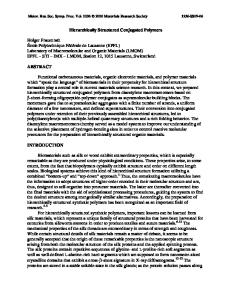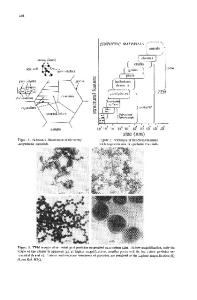Hierarchically Structured Silica Monoliths
- PDF / 1,039,805 Bytes
- 6 Pages / 612 x 792 pts (letter) Page_size
- 39 Downloads / 359 Views
P1.7.1
HIERARCHICALLY STRUCTURED SILICA MONOLITHS Nicola Hüsing, Christina Raab, Viktoria Torma Institute of Materials Chemistry, Vienna University of Technology, Getreidemarkt 9 A-1060 Vienna, Austria, [email protected]
ABSTRACT Large monoliths with periodic mesopores in a macroporous web-like network structure are prepared using a diol-modified silane as silica precursor and lyotropic liquid crystalline phases of surfactants in water as structure-directing agents. The surfactant concentration is varied from 5 to 40wt%. Highly porous materials are synthesized applying two different drying procedures: supercritical drying with CO2 or ethanol, in addition to ambient pressure drying including surfactant expulsion via silanisation treatments with trimethylchlorosilane or hexamethyl disilazane. The monolithic materials show a very unique macro- and mesostructure which is characterized by N2-sorption measurements, small-angle X-ray scattering (SAXS), transmission electron microscopy (TEM) and scanning electron microscopy (SEM).
INTRODUCTION Single molecules such as quaternary amines are used as structure-directing agents in the preparation of zeolites; for larger pores supramolecular arrays of molecules such as liquid crystal-like phases of surfactants are of interest, e.g. for templating mesoporous materials.[1] Through the choice of the surfactant dissolved in water, the pore sizes and the pore size distribution of the materials can be exactly tailored.[2] For plenty of applications, such as sensors, catalytic materials and separation media, not only the periodic build-up of the network but also the macroscopic morphology of the material is of crucial importance, often demanding monoliths instead of powders or films. In addition, a hierarchical built-up of the network structure is often required e.g. a well-defined combination of mesopores and macropores.[3] The synthesis of monoliths without randomly distributed mesopores such as aerogels is described in detail in several review articles, only few authors report on the preparation of periodically ordered M41S-type monoliths and even less describe the combination of surfactant templated monoliths with different pore sizes.[4-7] Because a direct templating approach of a liquidcrystalline surfactant phase with an inorganic precursor is typically applied in the preparation of mesostructured monoliths, one of the major problems observed in this process is the sensitivity of liquid-crystal phases towards alcohol which is released upon hydrolysis of the inorganic silica precursor, mostly tetraethoxy- or tetramethoxysilane. Hoffmann et al.[8] reported a novel glycol-based silica precursor, tetrakis(2-hydroxyethyl) orthosilicate which is water-soluble and compatible with lyotropic surfactant phases. We extended this research to the synthesis of low-density silica monoliths with an extraordinary network structure, applying the ethylene glycol modified silane (EGMS) in the presence of surfactants. In addition, we varied the drying procedure from the traditional
Data Loading...










